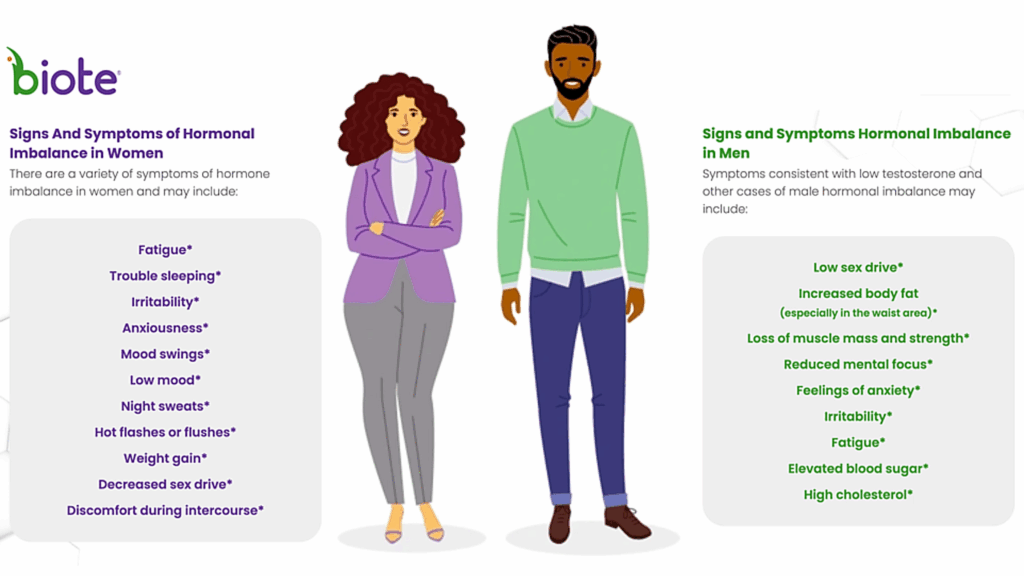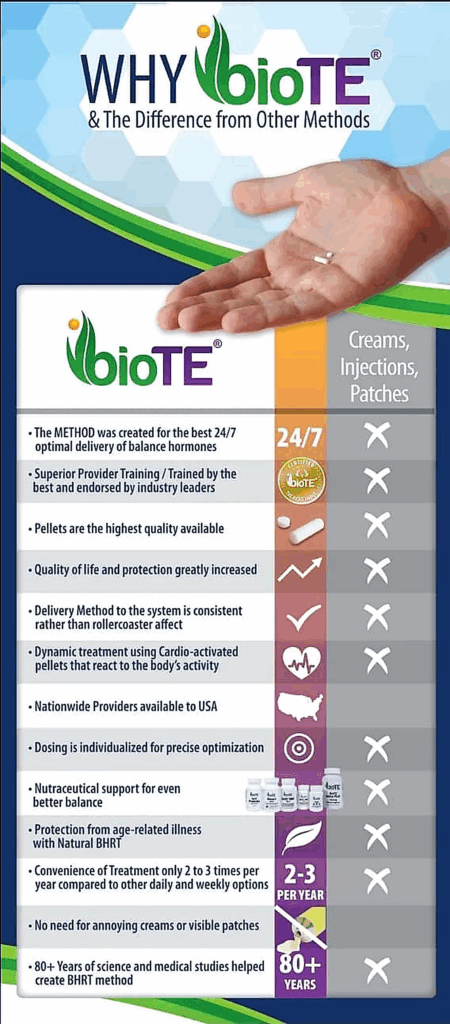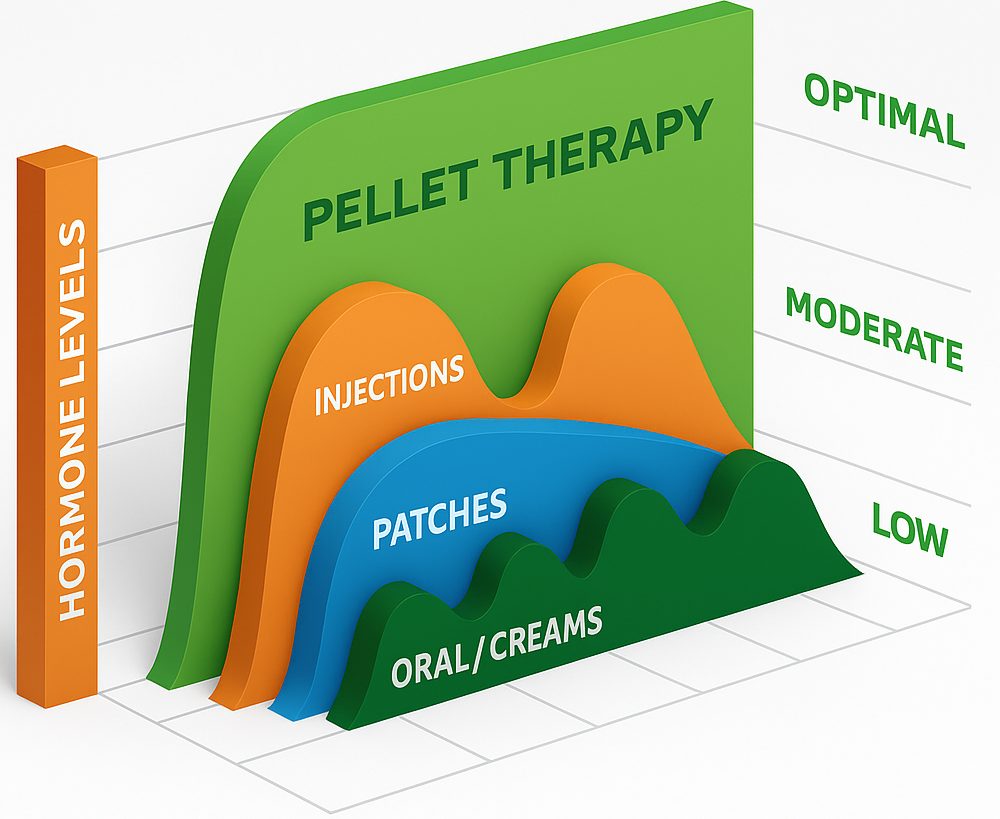Hormone Replacement Therapy
Jacksonville, FL
Personalized BioTE® Pellet Care
Why Patients Choose Pellet-Based Bioidentical Hormone Replacement Therapy
Pellet hormone replacement therapy delivers bioidentical hormones just under the skin for a steady, physiologic release over months—not hours—so you avoid the daily swings common with pills, creams, or short-acting injections. Most patients replace pellets every 3–6 months, which improves consistency and makes staying on plan easier.

Our BioTE® Approach (For Men & Women)
We’re a BioTE® Certified Provider. That means your care follows a structured, lab-guided method with high-quality, subcutaneous pellets that are tested for potency, sterility, and endotoxins. You’ll get a tailored plan based on symptoms, labs, medical history, and goals—with ongoing adjustments to keep you feeling your best.

Testosterone Therapy (Men & Women)
Low testosterone can show up as fatigue, muscle loss, low libido, brain fog, and stubborn weight. BioTE® testosterone pellets provide a consistent dose to restore balance—often with early improvements in 2–4 weeks, and full optimization after subsequent insertions. We monitor labs and outcomes to individualize your dose.
Estrogen Therapy (Women)
During peri- and post-menopause, declining estrogen can drive hot flashes, sleep disruption, mood changes, and vaginal dryness. Estrogen replacement with pellets aims to smooth fluctuations with a slow, steady release that supports symptom relief and quality of life—guided by your history, risk profile, and goals.
Calmer, steadier mood throughout the day.
Personalized dosing may ease irritability and anxious feelings.
Steadier energy—fewer midday crashes.
Feel motivated to move, work, and train.
Greater natural comfort and lubrication.
More confidence and connection with your partner.

BioTE® Pellets vs. Standard HRT
Pellets: Long-acting, subcutaneous implants that dissolve gradually—designed to deliver more consistent serum levels between visits (typically 3–6 months).
Daily/weekly HRT: (pills, gels, patches, short-acting injections) can be effective but often show peaks and troughs and require more frequent dosing.
Hormone Replacement Therapy Safety, Expectations, and Follow-up
No hormone replacement therapy is one-size-fits-all. Major medical centers note that “bioidentical” formulations are not proven safer or more effective than conventional HRT in general; what matters most is the right patient, dose, and delivery route with appropriate monitoring. Pellets are compounded and long-acting; we discuss benefits, risks, and alternatives before treatment and reassess regularly.
What is BioTE® pellet therapy?
BioTE® uses tiny bioidentical hormone pellets (estradiol and/or testosterone) placed just under the skin, where they dissolve and release hormone steadily over several months. The goal is symptom relief with a long-acting, consistent delivery.
What do I need before my first pellet appointment?
You’ll need baseline, pre-pellet lab work so we can dose accurately and confirm that BioTE® pellet therapy is appropriate for you. You can complete these labs with us or through your primary care provider—as long as results are current. The workup typically includes a comprehensive hormone panel, thyroid panel (TPO, TSH, Free T3, Free T4), CBC with differential, CMP, Vitamin D, Vitamin B12, and PSA for men. If you already have recent results, bring them to your visit (or send them ahead) so we can review and tailor your plan.
How long do pellets last—and how often are they replaced?
Most patients replace pellets every 3–6 months (roughly 2–4 times per year), depending on dose, absorption, and symptoms.
When will I feel a difference?
Many patients notice improvements within 2–4 weeks; full optimization can take up to 6 months, and some people feel their best after the second insertion.
What is the insertion like? Any downtime?
It’s an in-office procedure with local anesthetic and a small skin incision. No fasting is required. Afterward, avoid strenuous lower-body exercise for a few days and keep the site dry (no baths/hot tubs) as directed; walking and showers are generally fine.
Can pellets be removed if I don't like how I feel?
Pellets dissolve and are absorbed over time; they’re not designed to be removed. (One reason careful dosing and follow-up are important.)
How do you monitor and adjust dosing?
After your first insertion, labs are commonly checked at 4–6 weeks to assess levels and guide any adjustments at the next visit. For men on testosterone, guidelines advise checking hematocrit at baseline, 3–6 months, then annually, and monitoring testosterone levels and prostate parameters on a schedule you and your clinician agree upon.
What side effects or risks should I know about?
Possible issues include temporary insertion-site bruising/soreness and, rarely, infection or pellet extrusion. With testosterone therapy, an important risk is erythrocytosis (elevated red-blood-cell count), which is why hematocrit monitoring is standard.
What benefits are patients seeking with therapy?
For the right candidate, hormone therapy may ease vasomotor symptoms (hot flashes, night sweats), improve sleep, mood, vaginal comfort/libido in women, and support energy, libido, and body composition in men with true deficiency—balanced against individualized risks and monitoring.

What to Expect at Your First Visit
Your initial appointment includes a detailed medical review, symptom mapping, and targeted labs. We then design your BHRT plan (pellets and/or other routes), set follow-ups, and give you a clear after-care guide. Many patients love pellets for the “set-it-and-forget-it” convenience with consistent release between visits

Other Services
- Adrenal Dysfunction
- Cardiac Health
- Diabetes Management
- Food Sensitivity
- Functional Medicine Evaluation
- GI Disorders
- Inflammation
- Mood Disorders
- Neuropathy
- Nutritional Deficiency
- Nutritional IM Injections
- Peptides
- PRP Injections
- Regenerative Tissue Therapy Allografts
- Thyroid Testing and Management
- Weight Loss
(904) 373-1661

